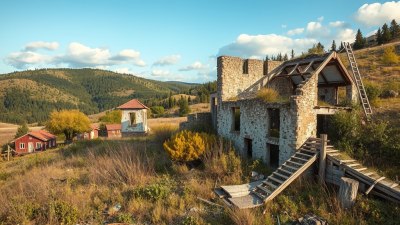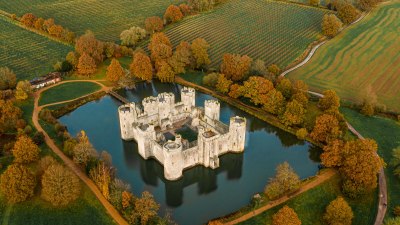The Landscape Adjusts to Your Leaving
Explore how landscapes transform in response to human departure and nature's reclamation.

In the intricate tapestry of life, the departure of humans from a space invokes a profound metamorphosis in the landscape around them. This phenomenon, often noticed in abandoned towns and overrun structures, showcases nature's resilience and adaptability. When people leave an environment, nature starts to reclaim what was once hers, creating an evolving tableau that tells the story of abandonment, growth, and renewal.
Throughout history, there have been countless instances of land transforming when left untended. The phenomenon is rooted in the principles of ecology, which assert that ecosystems are inherently designed to flourish without human interference. From crumbling urban environments to serene natural parks, the concept of landscapes adjusting to human leaving is multifaceted and profoundly inspiring.
Nature's Response: A Gradual Takeover
The initial response of nature to human absence is often gradual. In the beginning, small plants and weeds may emerge through cracks in pavement or spread over faded gardens. These pioneering species are resilient and can thrive in conditions where more complex plants may struggle. Their emergence marks the first step in a longer process of ecological succession, where diverse species gradually establish themselves, leading to increased biodiversity.
This phenomenon of reclamation can be exemplified by the Chernobyl Exclusion Zone in Ukraine. Following the catastrophic nuclear disaster in 1986, the area was abandoned, and nature started creeping back in. The disaster resulted in a dramatic decrease in human presence, leading to the land becoming a haven for wildlife. Within just a few years, deer, wolves, and various plant species began to thrive, demonstrating the powerful forces of nature at work. The Chernobyl site stands as a haunting reminder of the impacts of our existence and the resilience of nature.
Visual Transformations: Nature Paints Its Canvas
The visual transformation of landscapes post-human departure can be striking. Buildings once vibrant and bustling now succumb to the elements, with vibrant green vines climbing the walls and trees breaking through concrete. This merging of architecture and nature creates a living artwork that reflects the passage of time. The once sterile urban spaces transform into verdant havens, inviting wildlife and creating new ecosystems.
In Detroit, Michigan, the decline of the automotive industry led to many neighborhoods becoming desolate. However, these abandoned spaces have seen a resurgence of flora and fauna. Nature takes over, with wildflowers blooming amid rusting vehicles and trees sprouting from forgotten homes. These areas, once symbols of economic growth, now tell a different story of revival and the ability of ecosystems to adapt and flourish without human management.
The Role of Ecological Succession
Ecological succession plays a vital role in how landscapes adjust after a human exit. There are two primary types of succession: primary and secondary. Primary succession occurs on lifeless surfaces, such as bare rock, where soil must be generated from scratch. Secondary succession happens in areas where ecosystems have been disturbed but where soil and some organisms still exist, such as in abandoned farmland or towns.
In many urban centers that have experienced depopulation, secondary succession is predominant. The process begins with pioneer species that can endure the harsh conditions of disturbed soil. As time progresses, these early colonizers pave the way for more complex organisms, eventually leading to rich biodiversity as the area undergoes significant changes. This natural rhythm illustrates a beauty found in decay—a testament to the importance of each species in creating a balanced ecosystem.
Reflections on Human Impact
As landscapes adjust to our leaving, it serves as a poignant reflection on the human impact on the environment. Our presence has often led to disruption, habitat loss, and ecological imbalance. The stark contrast seen in regions that have been deserted highlights the fragility and impermanence of human achievements against the backdrop of nature's resilience.
Take, for instance, the town of Pripyat, once thriving due to its proximity to the Chernobyl Nuclear Power Plant. Post-disaster, Pripyat stands as a ghost town, and the landscape has dramatically shifted. Trees have reclaimed the city, with structures enshrined in a dense green overgrowth. The visual portrayal of a thriving civilization being overtaken by nature is both mesmerizing and sobering. It is a reminder that while humanity can erect magnificent buildings and foster sprawling cities, nature ultimately remains the master of the land.
Environmental Awareness and Education
The landscapes that adjust to our leaving provide crucial educational opportunities regarding ecological systems, resilience, and sustainability. As people begin to understand the intricacies of how nature flourishes in abandoned areas, there is a growing appreciation for biodiversity and the inherent interconnectedness of all living organisms.
This understanding fosters awareness regarding current environmental challenges, such as urban sprawl and habitat destruction. As deforestation and environmental degradation contribute to biodiversity loss, studying these abandoned landscapes reveals the importance of sustainable practices. A shift towards greener infrastructure and ecological restoration can foster environments that respect both human and natural systems.
Art and Literature Inspired by Abandonment
The theme of landscapes adjusting after a departure has also profoundly influenced art and literature. Various artists have captured the beauty of decay, portraying the juxtaposition of human creation and natural dominance. These representations evoke emotional responses that resonate with the viewer, prompting reflection on our place within the cosmos.
In literature, authors have explored the concept of leaving and return, often using nature as a metaphor for change and transformation. The writings depict a deep connection to landscapes, examining how they shape and are shaped by human experiences. The abandonment of places becomes a canvas for exploring themes of loss, resilience, and renewal—a recurring motif that inspires future generations to honor and respect the environment.
Conclusion: The Cycle of Life
As we examine the landscape adjusting to our leaving, we are greeted with a story of resilience, beauty, and eventual restoration. Nature’s ability to reclaim space once dominated by humanity serves as a humbling reminder of the intricate balance between our existence and the environment. Acknowledging this relationship encourages us to adopt sustainable practices, respect natural ecosystems, and recognize the need for conservation efforts.
As we move forward, it becomes essential to take note of the lessons taught by the landscapes adjusting to our absence. By fostering a deeper understanding of our environmental impact, we can build a future where development complements natural growth, ensuring a harmonious coexistence that honors both human creativity and nature’s enduring spirit. Ultimately, we are left with the question: how can we learn from the landscapes that transform in our leaving and ensure a more sustainable and respectful relationship with our planet?











